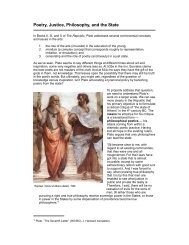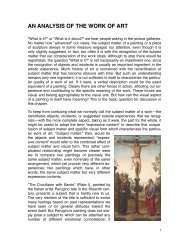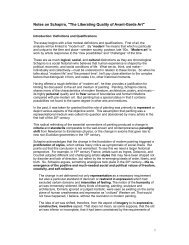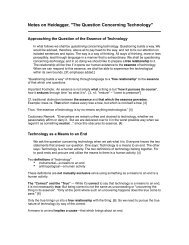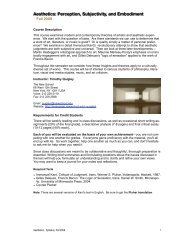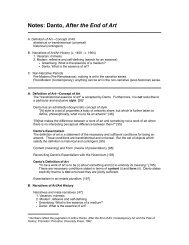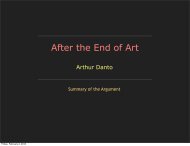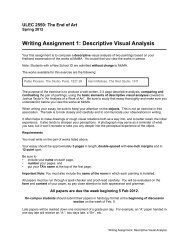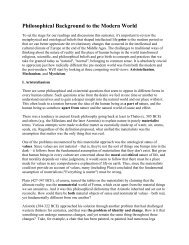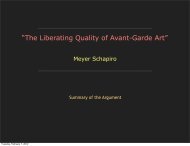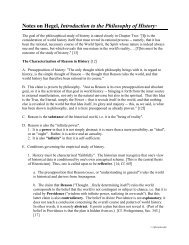You also want an ePaper? Increase the reach of your titles
YUMPU automatically turns print PDFs into web optimized ePapers that Google loves.
color, depth, which are there before us, are there only because they awaken an echo inour bodies <strong>and</strong> because the body welcomes them.Things have an internal equivalent in me; they arouse in me a carnal formula of theirpresence. Why shouldn't these correspondences in turn give rise to some tracingrendered visible again, in which the eyes of others could find an underlying motif tosustain their inspection of the world?[5] Thus there appears a "visible" to the secondpower, a carnal essence or icon of the first. It is not a faded copy, a trompe l'oeil, oranother thing. The animals painted on the walls of Lascaux are not there in the same wayas are the fissures <strong>and</strong> limestone formations. Nor are they elsewhere. Pushed forwardhere, held back there, supported by the wall's mass they use so adroitly, they radiateabout the wall without ever breaking their elusive moorings. I would be hard pressed tosay where the painting is I am looking at. For I do not look at it as one looks at a thing,fixing it in its place. My gaze w<strong>and</strong>ers within it as in the halos of Being. Rather thanseeing it, I see according to, or with it.Philosophical term for an objectwithout consciousness, as opposedto the being of a person (for-itself).The word "image" is in bad repute because we have thoughtlessly believed that adrawing was a tracing, a copy, a second thing, <strong>and</strong> that the mental image was such adrawing, belonging among our private bric-a-brac. But if in fact it is nothing of the kind,then neither the drawing nor the painting belongs to the in-itself any more than the imagedoes. They are the inside of the outside <strong>and</strong> the outside of the inside, which the duplicityof feeling [le sentir] makes possible <strong>and</strong> without which we would never underst<strong>and</strong> thequasi presence <strong>and</strong> imminent visibility which make up the whole problem of theimaginary. The picture, the actor's mimicry—these are not devices borrowed from the realworld in order to refer to prosaic things which are absent. For the imaginary is muchnearer to, <strong>and</strong> much farther away from, the actual—nearer because it is in my body as adiagram of the life of the actual, with all its pulp <strong>and</strong> carnal obverse exposed to view forthe first time. In this sense, Giacometti says energetically, "What interests me in allpaintings is likeness—that is, what likeness is for me: something that makes me uncoverthe external world a little."[6] And the imaginary is much farther away from the actualbecause the painting is an analogue or likeness only according to the body; because itdoes not offer the mind an occasion to rethink the constitutive relations of things, butrather it offers the gaze traces of vision, from the inside, in order that it may espousethem; it gives vision that which clothes it within, the imaginary texture of the real.[7]Shall we say, then, that there is an inner gaze, that there is a third eye which sees thepaintings <strong>and</strong> even the mental images, as we used to speak of a third ear which graspsmessages from the outside through the noises they caused inside us? But how would thishelp us when the whole point is to underst<strong>and</strong> that our fleshly eyes are already muchmore than receptors for light rays, colors, <strong>and</strong> lines? They are computers of the world,which have the gift of the visible, as we say of the inspired man that he has the gift oftongues. Of course this gift is earned by exercise; it is not in a few months, or in solitude,that a painter comes into full possession of his vision. But that is not the question;precocious or belated, spontaneous or cultivated in museums, his vision in any eventlearns only by seeing <strong>and</strong> learns only from itself. The eye sees the world, <strong>and</strong> what itwould need to be a painting, sees what keeps a painting from being itself, sees—on thepalette—the colors awaited by the painting, <strong>and</strong> sees, once it is done, the painting thatanswers to all these inadequacies just as it sees the paintings of others as other answersto other inadequacies.It is no more possible to make a restrictive inventory of the visible than it is to catalog thepossible expressions of a language or even its vocabulary <strong>and</strong> turns of phrase. The eyeis an instrument that moves itself, a means which invents its own ends; it is that whichhas been moved by some impact of the world, which it then restores to the visiblethrough the traces of a h<strong>and</strong>.In whatever civilization it is born, from whatever beliefs, motives, or thoughts, no matterwhat ceremonies surround it—<strong>and</strong> even when it appears devoted to something else—4



